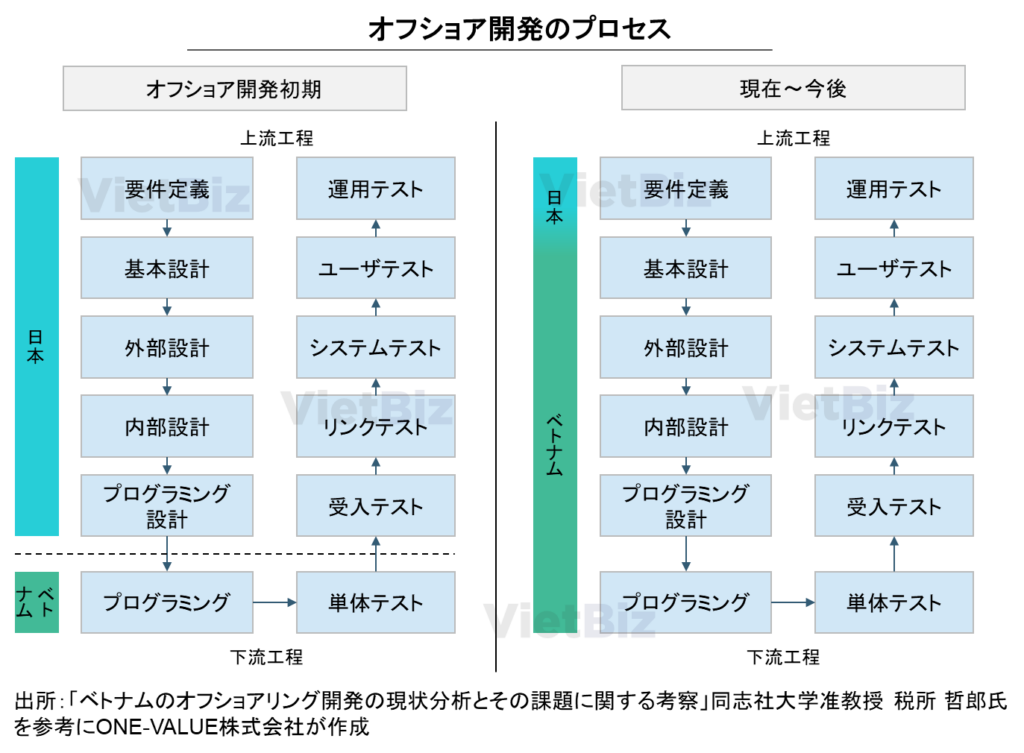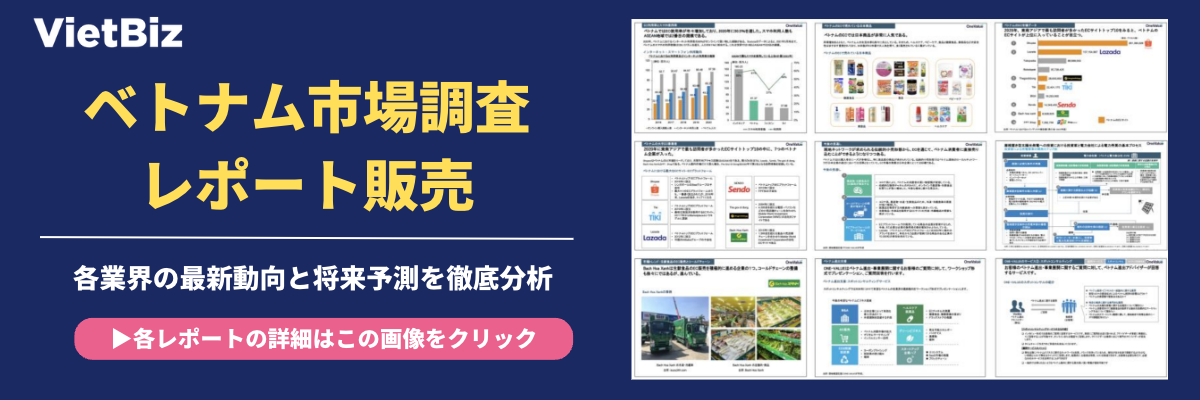What Is Offshore Development?
Offshore development is “Offshore Development” in English, where “Off” means “away from,” and “Shore” means “coast,” which in turn means a country. In other words, offshore development is a method of transferring and outsourcing IT-related development work, such as web systems and software, to overseas locations.
Purpose of Offshore Development
There are two main purposes for companies to conduct offshore development.
Reduced Development Costs due to Low Labor Costs
Most of the development costs of systems and software are labor costs for engineers. Therefore, outsourcing development to countries with low labor costs can greatly reduce development costs.
Complementing The Shortage of Human Resources in Japan
In Japan, not only is the cost of highly skilled IT personnel high, but there is also a shortage in absolute numbers to begin with. On the other hand, developing countries, especially those with large populations of young people, have an abundance of highly educated and talented human resources at universities and other institutions. For this reason, many companies are engaged in offshore development in order to supplement their IT human resources outside Japan, which is difficult to secure in Japan.
History of Offshore Development
Since around the 1980s, Japanese companies have been conducting offshore development in developing countries with low labor costs, and the number of projects and the scale of implementation have increased dramatically since the 2000s. In the early days of offshore development, the main outsourcing destinations were China and India.
Why China and India Were Chosen at The Dawn of Offshore Development
According to a survey conducted by the Ministry of Internal Affairs and Communications in 2007, the top three factors for Japanese companies in selecting an offshore development partner country were low labor costs, a large number of Japanese-speaking personnel, and a large number of highly skilled technical personnel.
Both China and India met the requirement of low labor costs, and China also had a large number of personnel who could use Japanese, since there were many students of Japanese. On the other hand, India was second in popularity after China because of its ability to communicate in English, although it did not have many people who could use Japanese. In addition, both the Chinese and Indian governments were focusing on the development of IT human resources within their own countries, so there was an abundance of highly skilled human resources in the labor market.
For the above reasons, much attention was focused on China and India in the 1980-2000s.
Vietnam’s Rise in the Offshore Development Market
In the late 2000s, however, labor costs in China and India began to gradually rise in line with economic development. In addition, demand for systems and software development increased within China and India, and the labor market is no longer as abundant in IT personnel as it used to be.
There is also the risk of concentrating outsourcing in one country. Examples include the suspension of economic activities in China due to infectious diseases such as Severe Acute Respiratory Syndrome (SARS) in 2002 and the new coronavirus (Covid-19) in 2020, and the reduction of business activities due to the anti-Japanese movement in 2005. Furthermore, the risk of information leaks in China, as exemplified by the “LINE problem” uncovered in 2017, cannot be ignored and could have a serious impact on Japanese companies on the outsourcing side.
In order to avoid the risk of concentration in a single country, the search for another offshore development partner country as “China +1” (China plus one) became active. Among these, “Vietnam” attracted particular attention.
Below, we will explain why Vietnam is attracting so much attention.
Advantages of Offshore Development in Vietnam
Below, we will explain why Vietnam has become the choice for offshore development, along with its advantages.
Abundance of Young, Talented people

Vietnam has a population of 97 million, with an average age of 31 years; by 2026, the population is expected to surpass 100 million. The university enrollment rate is increasing year by year. In particular, the number of students entering information and IT-related majors is high, and there is an abundance of highly knowledgeable young human resources.
Abundant Japanese-speaking Human Resources

In Vietnam, the number of Japanese language learners is very large, and Japanese is the second most popular second foreign language after English. In addition, Japanese companies, mainly in the manufacturing industry, have long been expanding their operations in Vietnam, and the Japanese government has provided a great deal of ODA and other international cooperation to the country.
The point that the country is pro-Japanese and has a large number of Japanese speakers is a major advantage in implementing offshore development.
Vietnamese Government Focuses on IT Human Resource Development

The Vietnamese government has positioned IT as one of the country’s key industries and is focusing on It human resource development, including the establishment of more IT departments in universities, new IT-related courses in vocational training schools, and training centers. In addition, the public and private sectors are cooperating to help university graduates re-enroll in IT technical schools and universities in order to encourage students who had already majored in science fields at university to switch to IT fields. These policies have been successful, and currently 50,000 students graduate each year after completing their IT specialization.
Tax Incentives for IT Businesses
The Vietnamese government has implemented generous preferential policies to make the IT industry a key industry for the country. One of these is a preferential corporate tax system. The corporate tax rate in Vietnam is normally 20%, but for software developers, a preferential tax rate of 10% is applied for 15 years.
Low Country Risks

The advantages of choosing Vietnam include low geopolitical risk, as well as political stability. For example, Myanmar, which was also attracting attention as an offshore development partner, experienced a military coup in February 2021, which changed the situation drastically. In other Southeast Asian countries such as the Philippines, a change of prime minister or president could also cause a major change in policy direction, which could affect corporate activities.
On the other hand, Vietnam has a stable political system with a long history of one-party dictatorship by the Communist Party. Vietnam has also built good relations with both eastern and western countries, and the risk of becoming embroiled in international conflicts is low. This high degree of stability in terms of domestic politics and diplomacy is a factor attracting many companies to Vietnam.
Geographical Proximity to Japan
The geographical proximity of Vietnam and Japan is one of the reasons why Vietnam is chosen as an offshore development partner country. Direct flights from Japan to Vietnam depart from Tokyo (Haneda/Narita), Osaka (Kansai International Airport), and Nagoya (Chubu International Airport), and it takes only 5~6 hours to travel there. In the course of offshore development, there may be occasions when business trips from Japan to Vietnam will be necessary. In such cases, the geographical proximity between Japan and Vietnam will be an advantage.
In addition, the time difference between Japan and Vietnam is only two hours (Japan is two hours earlier than Vietnam), which is not a major obstacle when holding meetings.
Challenges of Offshore Development in Vietnam
On the other hand, there are issues to keep in mind when conducting offshore development in Vietnam.
Communication Risks
When communicating with the Vietnamese side, including Vietnamese engineers, it is necessary to consider the risk of discrepancies in communication. Therefore, it is necessary to avoid ambiguous expressions and try to use clear and simple expressions. If you want to convey an image that is difficult to verbalize, it is better to explain it using similar examples or diagrams.
In recent offshore development, a bridge engineer is often assigned to bridge the communication between the Japanese and Vietnamese sides. The bridge engineer is not only proficient in both Japanese and Vietnamese languages, but also has knowledge of the development process. The bridge engineer serves as a liaison between the Japanese client and the Vietnamese engineer, and communicates instructions to the Vietnamese engineer as well as consultation issues from the Vietnamese client to the Japanese client.
As the number of offshore development projects between Vietnam and Japan has increased, the number of experienced bridge engineers has also increased. Therefore, communication risks are probably much lower than before.
Design Outsourcing Is Not Suitable for Offshore
In the course of development, it is said that UI/UX, which includes design elements, is not suitable for offshore development. This is because design preferences differ from country to country, making it difficult for Vietnamese to design what Japanese prefer. In addition, since design includes text input, etc., design by staff whose native language is not Japanese is a high hurdle.
In many actual cases, the design is done on the Japanese side and the coding is done offshore.
Need to Check Internal Controls of Outsourcing Partner
In the aforementioned “LINE problem” in China, the problem was that a Chinese company to which a Japanese company had outsourced its business had access to data. When outsourcing operations, one must also pay attention to the compliance and internal controls of the outsourced company.
The ordering party must also take measures such as not giving access rights to data containing personal information to the outsourcing company.
Types of Offshore Development
Offshore development can be classified into several types depending on its form.
Distinction by Resources Utilized
Offshore development is generally associated with outsourcing development work to a vendor in Vietnam, but there are also ways to utilize your own resources in Vietnam.

Outsourced Offshoring
Outsourcing offshoring is a form of outsourcing in which operations are outsourced to a completely third party that does not include the company’s own employees or its own group companies. For example, there is no local subsidiary in Vietnam, and development is outsourced to a local IT vendor.
In-house Offshoring
In-house offshoring is a form of offshoring in which operations are transferred overseas using the company’s own group resources, such as the company’s Vietnam base (including representative offices) and Vietnam subsidiaries. For example, this type of offshoring is chosen for medium- to long-term offshoring of operations, maintenance, and other tasks in addition to development. This is the case where a subsidiary is established in Vietnam, local personnel are hired, and the company establishes its own offshore base.
Distinction by Type of Business
Offshore development can also be distinguished by how the resources are utilized and how the work is segregated. It is necessary to use these forms differently depending on the content and scale of the development project.
Direct Contract Type

The form in which the client directly enters into an outsourcing contract with an overseas developer is called the “direct outsourcing type. This form has the advantage of being highly cost-effective because it is a simple form of directly outsourcing work to an overseas developer. On the other hand, it requires the client to directly handle contract procedures, work requests, and communication with the overseas developer, so the client also needs to have some knowledge of system development and offshoring.
Therefore, while it is an effective form of offshore development for companies that are somewhat familiar with it, it is somewhat risky for companies that do not yet have a proven track record.
Indirect Contractor Type

The client contracts with a Japanese IT vendor or consulting company, and the IT vendor or consulting company outsources the work overseas in what is called an “indirect outsourcing” type. In this type, a company bridges the gap between the client and the overseas developer, so the client is not aware that the work is being developed offshore, and can make a request as if the work were outsourced in Japan, without complicated contract procedures or communication.
Therefore, it is a form of offshore development that is easy to utilize for companies that have no experience with offshore development.
Laboratory Type

The above two types are “outsourced contracting” and orders are placed on a project basis, but the “laboratory type” is used as much as the outsourced contracting type. In the laboratory type, a contract is made with a team of engineers belonging to a company that provides offshore development services, and development is carried out under the client’s own direction. This is similar to renting a team of Vietnamese engineers from an offshore development company for the required number of man-months. In this case, the client is in control of the work, so it is possible to develop the project closer to their own image than in the outsourced contracting type. In addition, while the outsourced contracting type is basically only waterfall development, the lab type development allows agile development, which allows for more flexible development.
Offshore Development Process

In offshore development, the extent to which work is offshored overseas depends on the project. In the early days of offshoring to Vietnam, upstream processes such as requirement analysis/definition and basic design were often performed in Japan, while downstream processes such as programming were performed in Vietnam. This was because Vietnamese offshore development companies did not have the knowledge and know-how to perform the upstream processes. Today, however, an increasing number of offshore development companies and human resources in Vietnam have the ability to perform everything from programming to project management, in other words, the entire process from downstream to upstream.
Offshore Development in Vietnam Future Outlook
Until now, Vietnamese offshore development firms and IT human resources have been successful outsourcers of low value-added downstream processes. However, Vietnamese companies and human resources have acquired knowledge and know-how through years of experience, and are now able to perform upstream to downstream processes in a single pass, armed with advanced technical capabilities that rival those of Japanese IT vendors.
Vietnamese developers are not stopping at outsourcing, but are also developing their own applications and services. In the future, Vietnam’s IT industry is expected to move beyond offshoring to creating and developing its own products.

The Changing Relationship between Japanese and Vietnamese IT Development Companies
As the Vietnamese IT industry matures in this way, Japanese firms will not only outsource downstream processes as they have done in the past, but will also increasingly consult with Vietnamese development firms from the initial design of the system and the conceptual stage of the business model they wish to realize through development, and work together on development. In addition to the conventional outsourcing and contracting, we expect to see more cases of joint development and joint investment to build a higher level of relationship.
Summary
This report provides a comprehensive explanation of why Vietnam is being chosen for offshore development, as well as the current and future outlook for offshore development in Vietnam.
The 2020 outbreak of the new coronavirus had a major impact on the global economy, but it was more of a tailwind for the offshoring industry, as the remote, online connection of deals became the norm.
In Vietnam’s ever-changing IT industry, what kind of business can Japanese companies develop? Many possibilities are expanding.
ベトナム市場調査レポート一覧はこちらからもご覧頂けます。

ベトナム市場の情報収集を支援します
ベトナム市場での情報収集にお困りの方は多くいらっしゃるのではないでしょうか。
VietBizは日本企業の海外事業・ベトナム事業担当者向けに市場調査、現地パートナー探索、ビジネスマッチング、販路開拓、M&A・合弁支援サービスを提供しています。
ベトナム特化の経営コンサルティング会社、ONE-VALUE株式会社はベトナム事業に関するご相談を随時無料でこちらから受け付けております。






